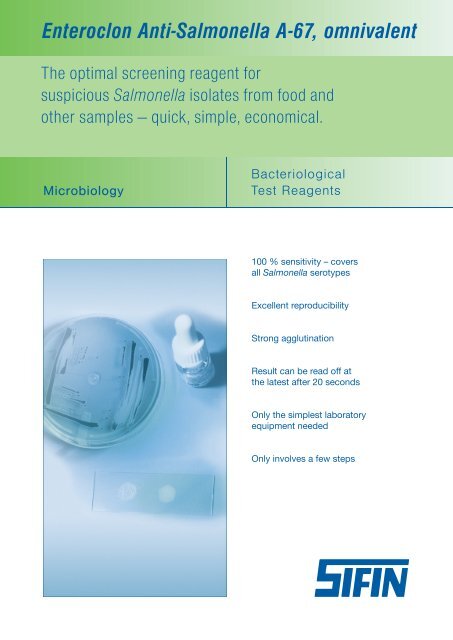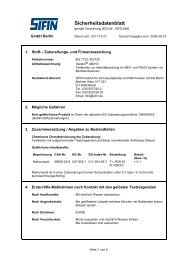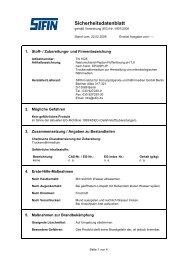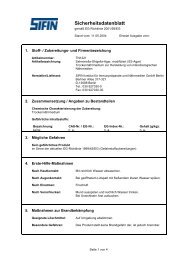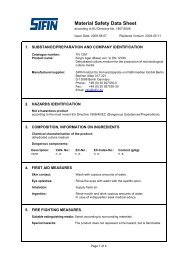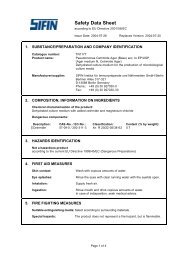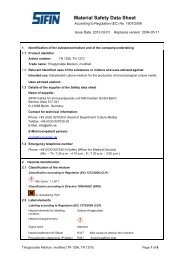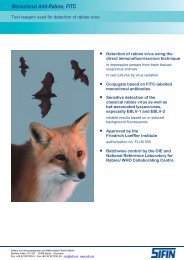Enteroclon Anti-Salmonella A-67, omnivalent - SIFIN
Enteroclon Anti-Salmonella A-67, omnivalent - SIFIN
Enteroclon Anti-Salmonella A-67, omnivalent - SIFIN
You also want an ePaper? Increase the reach of your titles
YUMPU automatically turns print PDFs into web optimized ePapers that Google loves.
<strong>Enteroclon</strong> <strong>Anti</strong>-<strong>Salmonella</strong> A-<strong>67</strong>, <strong>omnivalent</strong><br />
The optimal screening reagent for<br />
suspicious <strong>Salmonella</strong> isolates from food and<br />
other samples — quick, simple, economical.<br />
Microbiology<br />
Bacteriological<br />
Test Reagents<br />
100 % sensitivity – covers<br />
all <strong>Salmonella</strong> serotypes<br />
Excellent reproducibility<br />
Strong agglutination<br />
Result can be read off at<br />
the latest after 20 seconds<br />
Only the simplest laboratory<br />
equipment needed<br />
Only involves a few steps
<strong>Enteroclon</strong> <strong>Anti</strong>-<strong>Salmonella</strong> A-<strong>67</strong>, <strong>omnivalent</strong><br />
Salmonellosis is one of the most frequent<br />
infectious diseases caused by<br />
food and even in industrial countries<br />
its occurrence is tending upwards.<br />
Proceeding in accordance with § 64<br />
German Food and Feed Code, salmonellae<br />
are fi rst isolated by preenrichment,<br />
enrichment and subsequent<br />
cultivation on selective media, and<br />
then subjected to biochemical and serological<br />
confi rmation.<br />
Principle of the serotyping test<br />
<strong>Enteroclon</strong> <strong>Anti</strong>-<strong>Salmonella</strong> A-<strong>67</strong>,<br />
<strong>omnivalent</strong> is a mixture of 48 monoclonal<br />
antibodies. It is manufactured<br />
from cell culture supernatants of hybridoma<br />
cell lines which secrete antibodies<br />
against the corresponding<br />
group-specifi c <strong>Salmonella</strong> O antigens<br />
or the Vi antigen.<br />
<strong>Enteroclon</strong> is the term used by our<br />
company to designate products that<br />
are prepared exclusively from monoclonal<br />
antibodies. If the strain that is<br />
isolated possesses a <strong>Salmonella</strong> antigen<br />
which is covered by <strong>Enteroclon</strong><br />
<strong>Anti</strong>-<strong>Salmonella</strong> A-<strong>67</strong>, <strong>omnivalent</strong>,<br />
this antigen becomes bound when<br />
mixed with the specifi c antibody. The<br />
antigen-antibody reaction causes the<br />
strain to agglutinate in a clearly visible<br />
fashion.<br />
Materials<br />
For the serological confi rmation test<br />
only simple laboratory equipment is<br />
required:<br />
– glass slides<br />
– stirring rods<br />
– physiological saline<br />
Institut für Immunpräparate<br />
und Nährmedien GmbH Berlin<br />
Berliner Allee 317 - 321<br />
13088 Berlin<br />
Germany<br />
Fon + 49 - 30 - 92 70 30 0<br />
Fax + 49 - 30 - 92 70 30 30<br />
Mail info@sifi n.de<br />
Web www.sifi n.de<br />
How to perform the test<br />
Place one drop of<br />
the test reagent onto<br />
a slide<br />
➡ ➡ ➡<br />
Add a small amount of<br />
bacterial mass<br />
from a suspicious colony<br />
and mix it in so that a<br />
homogeneneous, slightly milky<br />
suspension results<br />
Holding the slide by hand,<br />
tilt it back and<br />
forth 1-20 times<br />
in front of a light source<br />
and then inspect it with<br />
the naked eye<br />
The result is available<br />
in almost no time at all<br />
Negative: The suspension remains<br />
milky-opaque even after it has been<br />
tilted back and forth 20 times.<br />
A negative result shows with certainty<br />
that the isolate is not <strong>Salmonella</strong> (diagnosis<br />
by exclusion).<br />
Positive: The suspension agglutinates<br />
after it has been tilted back and<br />
forth between once and 20 times, or<br />
in the case of a strongly positive reaction,<br />
even while it is being mixed.<br />
Specifi city: In exceptional cases, antigen<br />
identities or related antigens may<br />
lead to cross-reactions with other genera<br />
of the Enterobacteriaceae family<br />
(e.g. with strains of Citrobacter spp.,<br />
Morganella spp. or Proteus spp.). For<br />
this reason, it is necessary to ensure<br />
that the sample belongs to the <strong>Salmonella</strong><br />
genus biochemically (see the<br />
scheme below, right).<br />
The classical agglutination test<br />
using<br />
<strong>Enteroclon</strong> <strong>Anti</strong>-<strong>Salmonella</strong> A-<strong>67</strong>,<br />
<strong>omnivalent</strong><br />
is the rapid test<br />
‚par excellence‘<br />
Products<br />
Further serological differentiation is<br />
performed using the group-specifi c<br />
and monospecifi c <strong>Enteroclon</strong>s or test<br />
sera in accordance with the Kauffmann-White<br />
Scheme.<br />
Product Number<br />
<strong>Enteroclon</strong> <strong>Anti</strong>-<strong>Salmonella</strong><br />
(A-<strong>67</strong>), <strong>omnivalent</strong><br />
<strong>Enteroclon</strong> <strong>Anti</strong>-<strong>Salmonella</strong><br />
I (A-E)<br />
<strong>Enteroclon</strong> <strong>Anti</strong>-<strong>Salmonella</strong><br />
II (F-<strong>67</strong>)<br />
<strong>Enteroclon</strong> <strong>Anti</strong>-<strong>Salmonella</strong><br />
Poly-H Phase 1 & 2<br />
Test reagents for serological<br />
differentiation<br />
Buffered<br />
Peptone Water<br />
Magnesium Chloride<br />
Malachite Green Broth<br />
acc. to Rappaport-<br />
Vassiliadis (RV-Medium)<br />
Selenit Cystine Bouillon<br />
Brilliant Green Phenol Red<br />
Agar acc. to<br />
Edel and Kampelmacher<br />
(BPLS-Agar, mod.)<br />
MSRV Medium Base (Modifi<br />
ed Semi-Solid Rappoport<br />
Vassiliadis Medium Base)<br />
Desoxycholate Citrate Agar<br />
(DCLS-Agar), Modifi ed<br />
XLD-Agar acc. to ISO 6579<br />
(Xylose Lysine<br />
Deoxycholate Agar)<br />
SS-Agar, modifi ed (<strong>Salmonella</strong>-Shigella<br />
Agar, mod.)<br />
Swarm Agar<br />
Literature<br />
TR 1101<br />
TR 1105<br />
TR 1111<br />
TR 1115<br />
TR 1121<br />
TR 1125<br />
TR 1141<br />
TR 1145<br />
acc. to<br />
catalogue<br />
TN 1137<br />
TN 1226<br />
TN 1157<br />
TN 1183<br />
TN 1110<br />
TN 1272<br />
TN 1121<br />
TN 1122<br />
TN 1196<br />
TN 1221<br />
1 ml<br />
5 ml<br />
1 ml<br />
5 ml<br />
1 ml<br />
5 ml<br />
1 ml<br />
5 ml<br />
500 g<br />
5 kg<br />
500 g<br />
500 g<br />
500 g<br />
500 g<br />
500 g<br />
5 kg<br />
500 g<br />
500 g<br />
TN 1702 20 x 10 ml<br />
Biochemical Confi rmation<br />
Genus LDC KCN PYR NPA<br />
<strong>Salmonella</strong> + - - -<br />
Citrobacter - + + -<br />
Proteus - + - +<br />
Morganella - + - +<br />
Lysine decarboxylase<br />
Potassiumcyanide test<br />
Pyrase test<br />
Phenylalanine desaminase<br />
Size<br />
Mohr, J und G Pollex: Agglutinating monoclonal<br />
antibodies in diagnosis of salmonelloses. Biotest<br />
Bulletin 6: 75-83 (1998)<br />
Date of revision: October 2007


